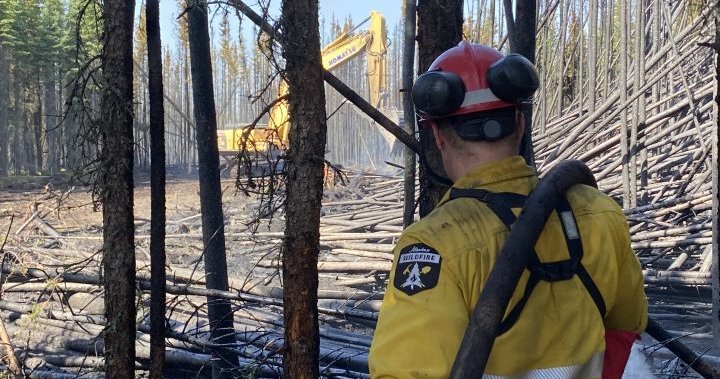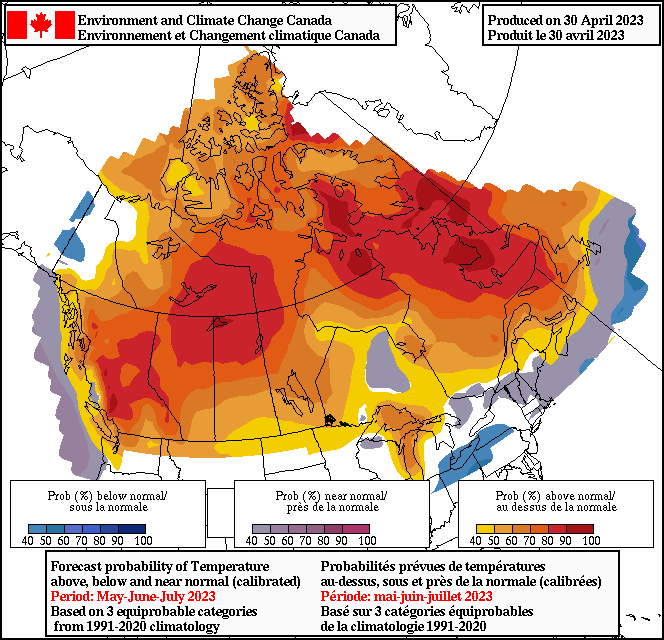
Canada’s wildfire season is off to a blistering start as multiple provinces are battling more than 200 blazes across the country.
The province of Alberta is under a state of emergency with nearly 30,000 people evacuated in the past week.
As of Tuesday morning, there were 89 active fires burning in the province, including 26 listed out of control.
Drayton Valley evacuation in Alberta, Friday, May 5, 2023.
yDave Carels/Global News
British Columbia was reporting 58 active wildfires but only 6 of those were out of control, according to the B.C. Wildfire Service.
There has been some wildfire activity in Saskatchewan as well, with 20 active blazes, as of Tuesday.
In Manitoba, municipalities and the wildfire service are beginning to see some fires across the south and central regions, but at this point, they have been human-caused, the government said in an update last week.
More hot and dry conditions in the coming weeks could add fuel to the fire, with the Prairies at an “extreme risk,” said Ross Hull, Global News meteorologist.
“I think what we’re looking at is certainly a concerning pattern for … the remainder of this month it looks like for many of those areas impacted, especially Alberta, Saskatchewan, perhaps portions of Manitoba and north or northeastern B.C.,” he said.
Fire danger forecast for Monday, May 15 2023.
Photo courtesy: Natural Resources Canada
In Alberta, which is at the highest preparedness level (4), there has been some respite over the past couple of days with light scattered showers and winds, allowing firefighters a helping hand, said Christie Tucker, information unit manager for Alberta Wildfire.
But the province is “not out of the woods yet,” she said during a news conference Monday.
“We’re expecting to warm up towards the weekend, which could raise fire danger levels again, and we anticipate wind direction could shift, which will change how we tackle these fires.”
Besides the Prairie provinces and northeastern B.C., the Northwest Territories are also at “highest risk” of wildfire activity, according to Hull.

Temperature probability forecast for May-July 2023.
Photo courtesy: Environment and Climate Change Canada
Meanwhile, in the east, there is a likelihood of some wildfires developing in parts of Ontario and Quebec, but that risk is not as high as out west, said Hull.
Canada’s wildfire season typically starts in April, hits its peak in July and ends in October.
A burned section of forest in the area near Edson, Alta., is seen in a May 6, 2023, handout photo.
THE CANADIAN PRESS/HO-Government of Alberta Fire Service, *MANDATORY CREDIT*
What Alberta is experiencing is not unusual as May is typically a busy wildfire month for the province, said Chelene Hanes, a wildfire research scientist with the Canadian Forest Service.
She said much of what the rest of the season will look like depends on whether the drought conditions persist into the summer months.
The often wet period of “June monsoons” in B.C. and Alberta could help calm things down, Hanes said.
How is Canada responding to wildfire risks?
In Alberta, more than 700 firefighters, along with heavy equipment and air tankers have been responding to the wildfires, said Tucker.
Additional firefighting resources have also been requested and arrived from other provinces to help Alberta.
The federal government has committed it “will be there” to help. Alberta Premier Danielle Smith told reporters at a press conference Monday afternoon she had been assured by Prime Minster Justin Trudeau that the Canadian Armed Forces will be deployed to assist.
The B.C. Wildfire Service has deployed six incident management teams, comprising highly skilled personnel, to battle the early season wildfire in the province.
To help fire management agencies better prepare for the season, the Canadian Forest Service has been working to upgrade its decades-old models, taking into consideration the changes in weather and the influence of drought.
Satellite image of Alberta wildfires on May 5, 2023.
Photo credit: National Oceanic Atmospheric Administration
The Canadian Forest Fire Danger Rating System has been in development since 1968 but the Canadian Forest Service has begun using new technology, including weather stations, remote sensing and satellite.
“In the past, we looked at daily models,” said Hanes. “Now we’re able to move to more hourly systems and to incorporate … a number of different technological and computing advances that can help fire managers in their decision making.”
Canada is also developing a system that aims to monitor all active wildfires in the country from space on a daily basis.
The WildFireSat mission by the Canadian Space Agency, Natural Resources Canada and Environment and Climate Change Canada is slated for launch in 2029.
The government says this will help reduce wildfire losses through more precise wildfire monitoring, improving our ability to make informed decisions about defending communities and avoiding unnecessary evacuations.
© 2023 Global News, a division of Corus Entertainment Inc.














